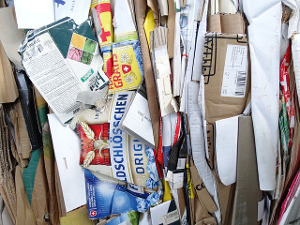Overview
Paper covers everything from packaging to mail envelopes. It makes up 33% of the total municipal solid waste stream. However, it’s also one of the most recycled materials.
 Unlike glass and metal, paper’s quality deteriorates significantly in the process of recycling. It’s impossible to produce the same tier of paper using current methods. This means that, at least for the foreseeable future, we’ll continue to produce industrial quantities of paper, but this doesn’t mean that we shouldn’t focus on recycling it, either. Lots of our needs fall into a lower tier so we don’t need to make new materials where recycling works just fine.
Unlike glass and metal, paper’s quality deteriorates significantly in the process of recycling. It’s impossible to produce the same tier of paper using current methods. This means that, at least for the foreseeable future, we’ll continue to produce industrial quantities of paper, but this doesn’t mean that we shouldn’t focus on recycling it, either. Lots of our needs fall into a lower tier so we don’t need to make new materials where recycling works just fine.
How to Recycle Paper at Home
Even though paper loses a part of its quality in the process of recycling, large portion of our demand can be covered by this production. It only makes sense that we recycle as much as we can, in this case. Here’s how to recycle paper at home:
- Learn the difference between recyclable and non-recyclable paper. Different facilities have different policies, but there are certain types of paper that are generally non-recyclable and you shouldn’t waste your time with them. Things like waxed paper, laminated paper, or stained paper are non-recyclable. However, you can recycle newspapers, magazines, packaging, cardboard, envelopes, office paper, and any other form of paper of this sort.
- Contact your local recycling centre. This should be your second step after you make sure that you have recyclable paper on the account of the fact that some recycling facilities do not take certain types of paper, while others do. You should ask about the specifics and work out how to proceed from there.
- Remove all the soiled or greasy paper. Unlike metals and glass which are processed with heat, paper is recycled using water. If there is grease or any other contaminants, they can ruin the whole batch regardless of whether they are water-soluble or not.
- Sort the paper. Different types of paper have a different fiber length, and thus a different quality. That’s why it’s important to have them sorted by type. Cardboard goes to cardboard, office paper goes to office paper, etc.
- Bring your sorted paper to the closest recycling centre or deposit it in a recycling bank. At this point, you have several options. You can simply leave the sorted paper in a kerbside box or a bin. You can also deposit it in a recycling bank or bring it to the closest recycling facility.
How Is Paper Recycled?
Step 1: The paper is collected by your local council and then categorised based on its quality.
Step 2: A paper mill is used to separate the paper fibres into types. This is done using chemicals such as caustic soda and hydrogen peroxide, in combination with soap and water. Afterwards, screening ensures the removal of any debris.
Step 3: Fibres are cleaned and de-inked again and again in a floatation tank – they’ll become whiter each time. Whitening agents are then added and the pulp is pumped onto a paper machine.
Step 4: The paper is passed over a vibrating machine, or through rollers. This removes the majority of the water.
Step 5: Heated rollers are used to dry the paper. The temperature of these rollers reaches up to 130 degrees. The paper is made smoother and whiter as a result.
Step 6: The paper is dried again and then run through a specialist machine which acts as an ironing board.
Step 7: Various of tests are being made to make sure paper’s gloss, brightness, and strength all meet the required standard.
3. Did You Know
- A newspaper can be recycled, used to create a new one, and then put up for sale in just seven days
- Almost 70% of the paper and cardboard used in the UK is recovered for recycling
- 11 million tonnes of CO2 emissions are avoided by simply recycling paper
The Environmental impact
A lot of energy can be saved by using old paper, instead of raw materials to create new sheets. When card and paper is sent to a landfill it rots and emits methane. Every time a piece of paper is recycled its fibres get shorter, and its quality is reduced. When fibres can no longer be reused to create new paper, they’re used for soil conditioner, energy generation, or just sent to a landfill.
FAQs
Q: Is all paper recycled in the same way?
A: Paper is made up of fibres, and the longer the fibre, the richer the paper. These fibres become shorter every time the paper is recycled and eventually the material will only be able to create toilet paper or tissues.
Q: Can I recycle soiled or wet paper?
A: No. Food, oil, grease, and other liquids all contaminate the paper recycling process.
Q: Can I recycle shredded paper?
A: Yes, but bear in mind that shredding your documents shortens their fibres and lowers the grade of the paper from high, down to mixed. Mixed grade paper is still recyclable but you may have trouble finding a recycler that will take it.





